In the days when visitors to Estonia often arrived by sea, the first glimpse of Tallinn, the capital, made a lasting impression. Its ancient ruins and quaint houses with steeply peaked roofs, more Mediterranean than Baltic, captivated many visitors. In summer, it might have been the south of France, with early 19th-century Russians making an annual summer pilgrimage from St Petersburg. “I have seen delicate creatures,” wrote an English visitor in 1841, “who at first were lifted from the carriage to the bathing-house, restored day by day, and in a fortnight’s time bathing with a zest that seemed to renew all their energies.”
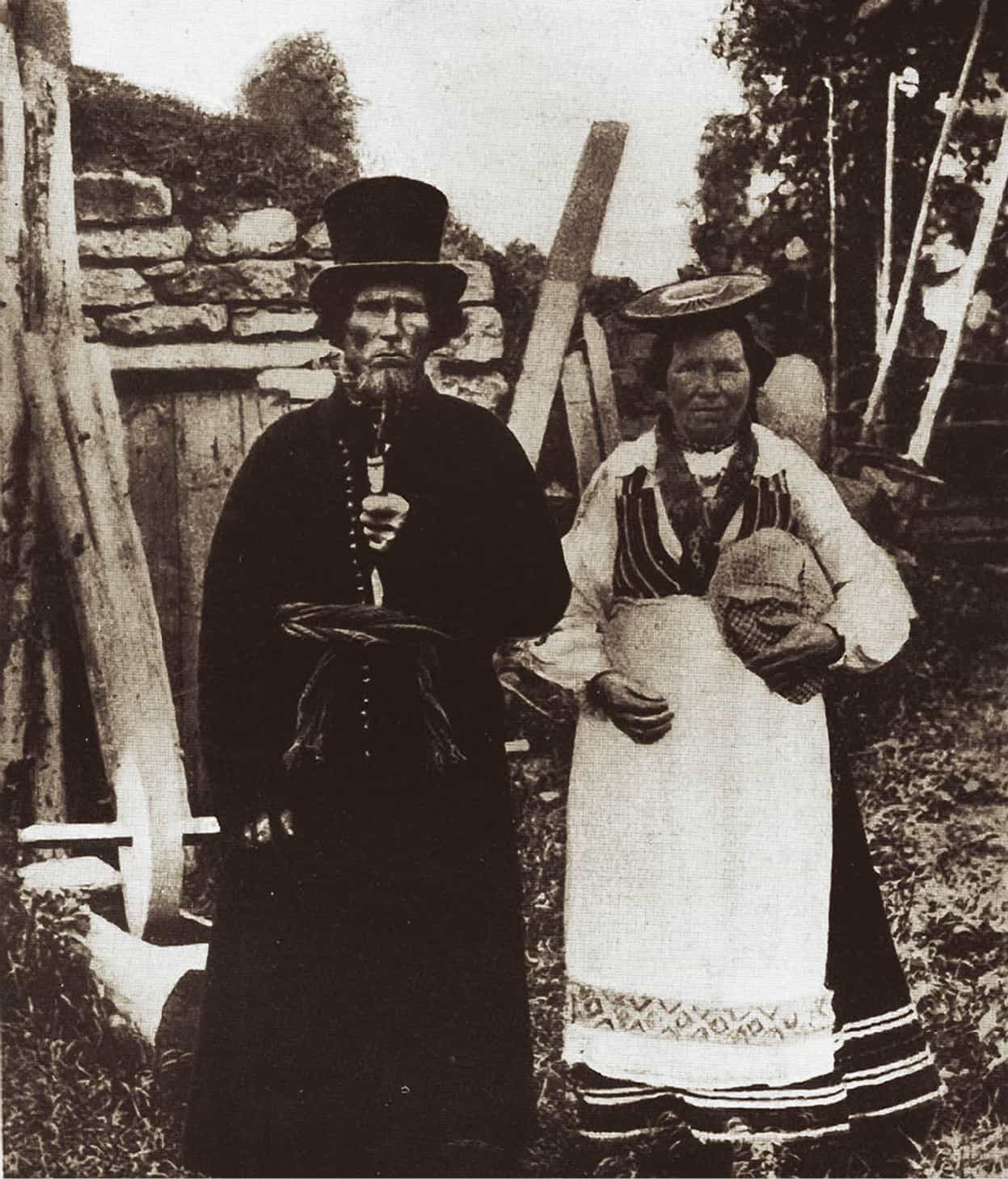
Saaremaa islanders, around 1920.
Eesti Ralva Museum
In the evenings, “a band of military music plays, and restaurants offer ices, chocolate, etc., and you parade about and your friends join you, and you sit down and the gnats sting you; and if you don’t like this, you may adjourn to the salle de danse close by, where the limbs so late floating listlessly on the waves now twirl round in the hurrying waltz.”
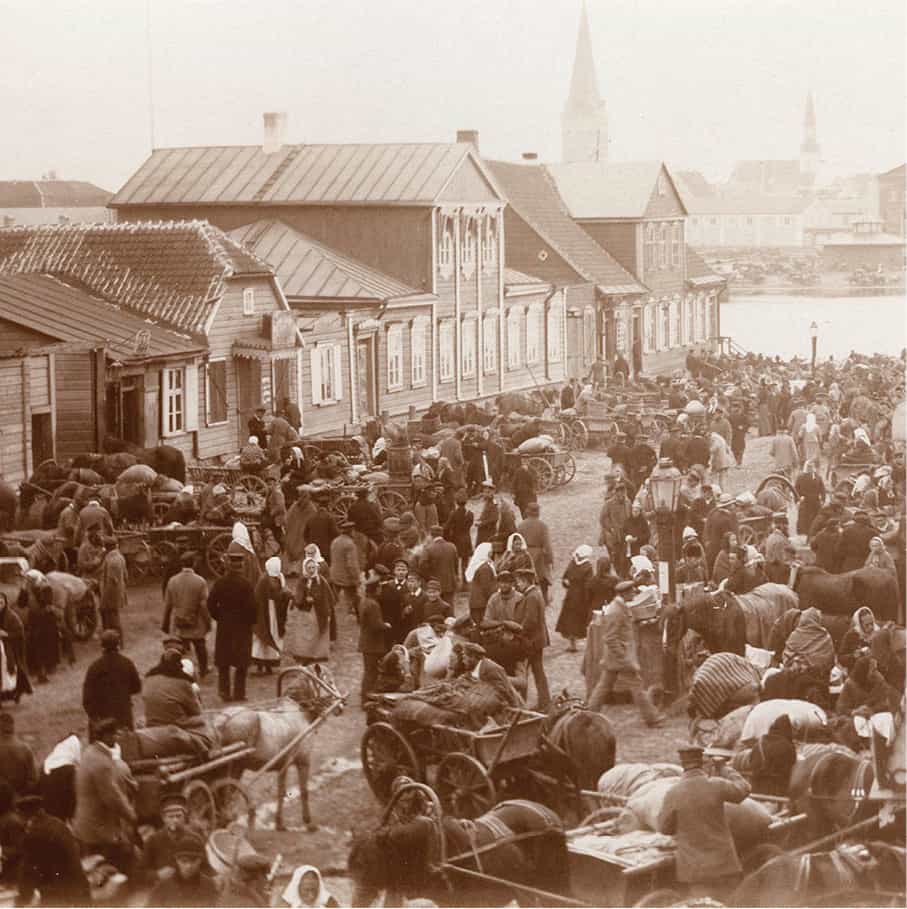
At the peasant market in early 20th-century Pernau.
Mary Evans
Estonia had been a Russian province since 1721, and while the lot of the Estonian peasant had been pathetic for many years (and most ethnic Estonians were peasants), tsarist rule became increasingly repressive. By the late 19th century there were no more foreign tourists, Russians excepted, and as far as most foreigners were concerned, Estonia ceased to exist.
In 1988 nearly a quarter of the population of Estonia gathered in Tallinn in a mass singing demonstration against the USSR, which became known as the “Singing Revolution”.
A curious race
A declaration of Estonian independence after World War I caught the world by surprise. Russia, torn apart by revolution, was unable to do much to counter the move. Authors of travel guides rushed in to appraise the reincarnated nation. “The broad visage of the Estonian,” wrote one, as if reporting on a newly arrived specimen at a zoo, “has slanting eyes, low forehead, high cheekbones and projecting lower jaw.” His conclusion was that Estonian origins were “not of Europe”. Estonian independence lasted only until World War II. It then disappeared under the even heavier hand of Communist Russia and was presumed lost for all time. Rather suddenly in 1988, extraordinary reports were received in the West of a “Singing Revolution”. Tens of thousands apparently spent that summer giving throaty voice to all the old Estonian songs and defiantly waving the long-hidden national flag. Within two years, although not without moments of nail-biting uncertainty, Estonia was independent again.
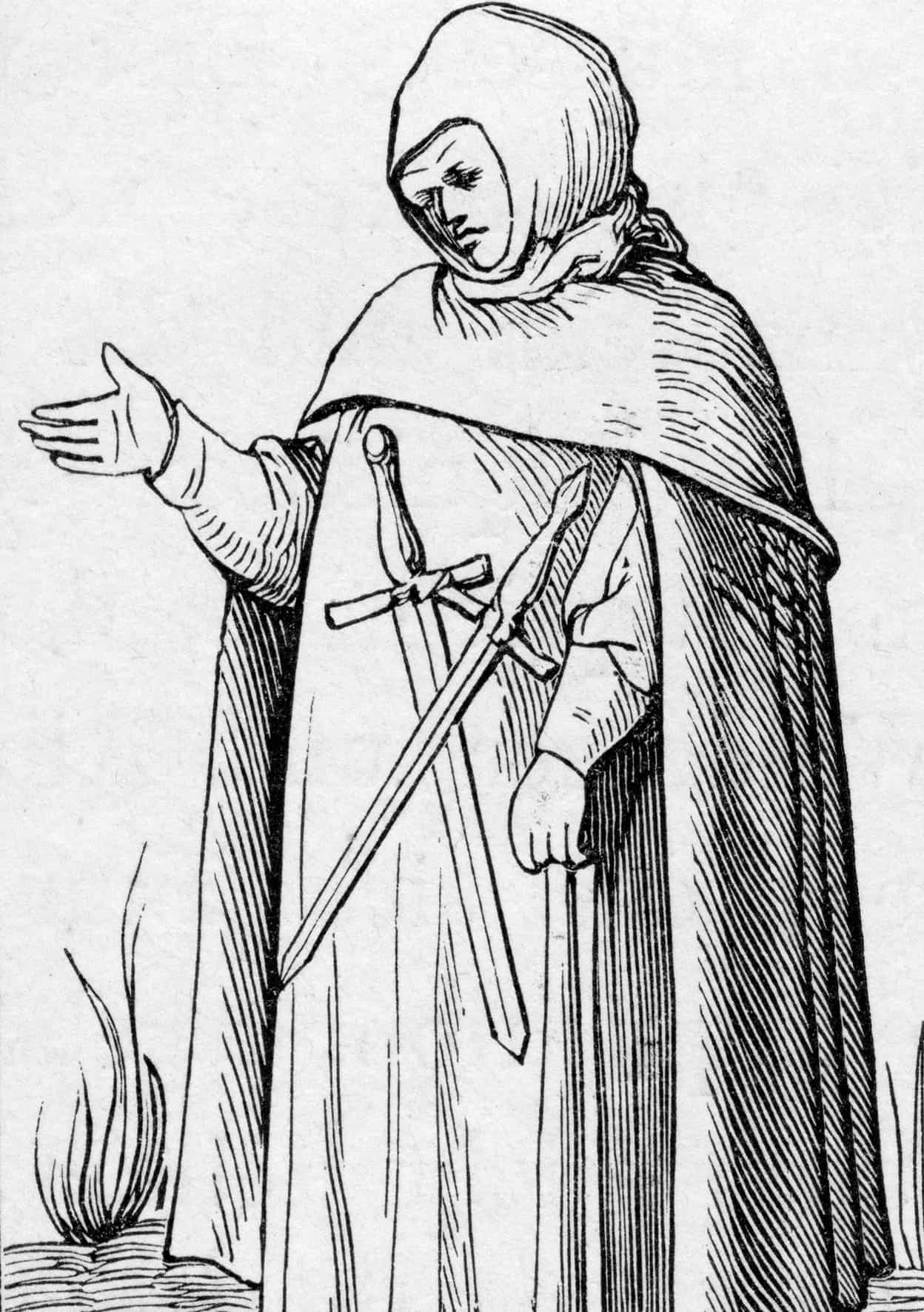
A member of the Livonian Brothers of the Sword.
Mary Evans
For all the ravages of a Soviet economic policy that had aimed at turning Estonia into an annexe of heavy industry, much of the character that delighted visitors of 150 years ago had survived. Russians were still visiting the country in droves, but for the “Old European” atmosphere and the food rather than the beaches and swimming, which were prime casualties of environmental vandalism.
As for the newly independent Estonians, they had borne the burden of the previous half-century with fortitude. The “non-European” physical features of the ethnic Estonians are a reflection of Finno-Ugric ancestry. Because of the similarities between the Estonian and Finnish languages, Estonians had been able to follow Finnish television during the Soviet era. Its terms of reference did not flatter the Soviet system.
Rise and fall of the manor
The most striking echoes of Estonia’s feudal past can be found in the grand manor houses that dot the countryside. Some estates date back to the 13th century, when newly arrived Germanic lords staked out their holdings with wooden structures or fortified strongholds. In the 18th century, the manor house saw its heyday as families with the means built palatial Baroque and neoclassical complexes. Regular rows of chestnut or birch trees flank rural roads, indicating the approach to old manors. Many of them survived the Soviet era and have been spectacularly restored. For more information, click here.
Mixed nationalities
Estonia’s frontiers have been chopped and changed over the centuries. Their present configuration makes Estonia a country of some 44,000 sq km (17,000 sq miles), small enough to be covered by a day’s driving in any direction, with a population of slightly more than 1.3 million, of whom about 69 percent are ethnic Estonians. The remaining 31 percent are predominantly Russians, most of whose families were sent in to man the industries that represented Estonia’s role in the Soviet economic scheme. A few people living in the eastern part of the country are the descendants of 17th-century Old Believers, a sect that fled from Russia to escape, among other things, the tax that Peter the Great imposed on the beards they wore.
An additional group are the diluted remnants of Estonia’s most influential settlers, the Germans. The latter came in two guises: the first were 13th-century Teutonic Knights who arrived ostensibly as bearers of Christianity but also as migrants with an urgent need to find somewhere to live, having recently fallen on hard times in the Holy Land; these people were followed by German craftsmen and merchants who formed the burgher class that ultimately monopolised the towns and cities. To an unusual degree, Estonians have taken a back seat while others have written their history. These 13th-century Germans were not the first to arrive, and many others followed after them.
Hardy beginnings
The future Finns and Estonians were among the first tribes to drift across Europe from Asia. Leaving the lower slopes of the Urals, they followed the river courses, subsisting mainly on fish, and clothing themselves in animal skins. They had already reached the Baltic coast when mentioned by Tacitus in the 1st century AD. “Strangely beast-like and squalidly poor, neither arms nor homes have they. Their food is herbs, their clothing skin, their bed the earth. They trust wholly to their arrows, which, for want of iron, are pointed with bone . . . Heedless of men, heedless of gods, they have attained that hardest of results, the not needing so much as a wish.”
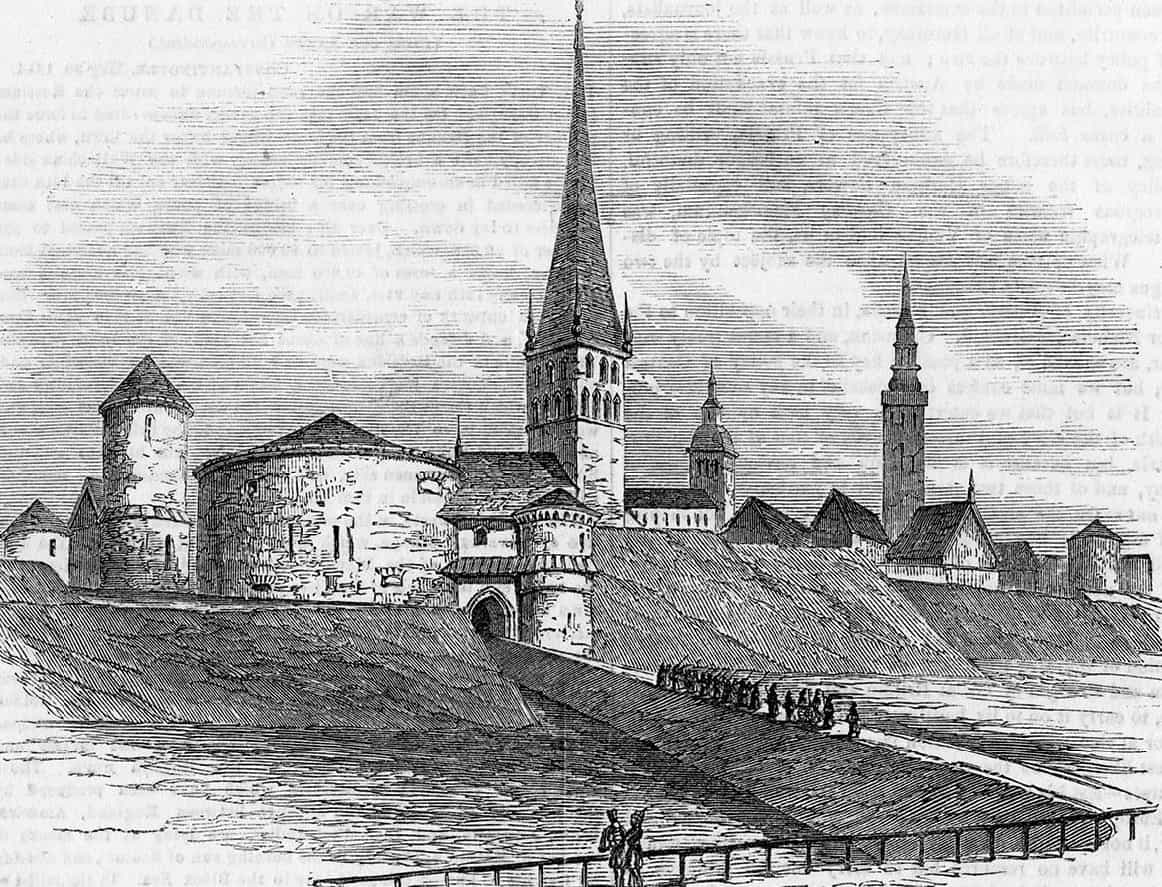
The Inner Fort of Tallinn, formerly known as Revel.
Mary Evans
There seems to have been some pushing and shoving among new arrivals on the Baltic shores, especially when large numbers of Slavs turned up, but eventually the future Finns, Estonians, Latvians and Lithuanians took up positions in more or less the same pattern that persists today.
The first conquerors were the Danes under Valdemar II, who arrived with what should have been an invincible armada of 1,000 ships. The Estonians resisted the invasion so fiercely that the Danes were in danger of being routed. They were rescued, so the story goes, by a red banner with a white cross floating down from heaven – the image that was to inspire the future Danish flag. Their spirits up, they took possession of Tallinn.
Some years earlier, in 1200, around 500 heavily armed German knights had landed further south in the Gulf of Rīga with a commission to spread the word of God. They did so more efficiently than the Danes, who were themselves recent converts.
The rule of the knights
In the end, the Danes asked the Teutonic Knights to lend a hand against the Estonian pagans. The knights tackled the task with customary efficiency and declared, in 1227, that, finally, the job had been accomplished. The knights transformed an economy, which had previously rested on primitive agriculture and products of the forest, into one of the best centres of farming and commerce of the Middle Ages. They constructed castles and founded towns everywhere, filling them with craftsmen and merchants recruited from Germany. Their social system was simple: Germans occupied the positions of noble, burgher and merchant; the Estonians were serfs.
This system survived political and religious change for seven centuries. In the year 1347, the Danish monarchy was desperate for cash. Tallinn, or Reval as it came to be known, was sold off to the efficient and prosperous knights. A large part of the commercial success of Reval and Narva, Estonia’s two ports, was due to a virtual monopoly on trade to and from Russia. When Ivan III seized Narva and made it a Russian port it so alarmed the Baltic Germans that they sought the protection of Sweden. Under Gustavus Adolphus, Sweden was energetically bent on expanding its Baltic holdings, but there was no desire to tamper unnecessarily with a German infrastructure that worked so profitably. Later Swedish kings, particularly Charles XI, did interfere by taking over German-owned estates and either giving them to Swedes or, increasingly, keeping them for themselves. The dispossessed and disgruntled, who had previously turned to Sweden for protection against Russia, decided they now needed protection from Sweden. With perfect impartiality, they turned to Russia. Peter the Great readily agreed to help.
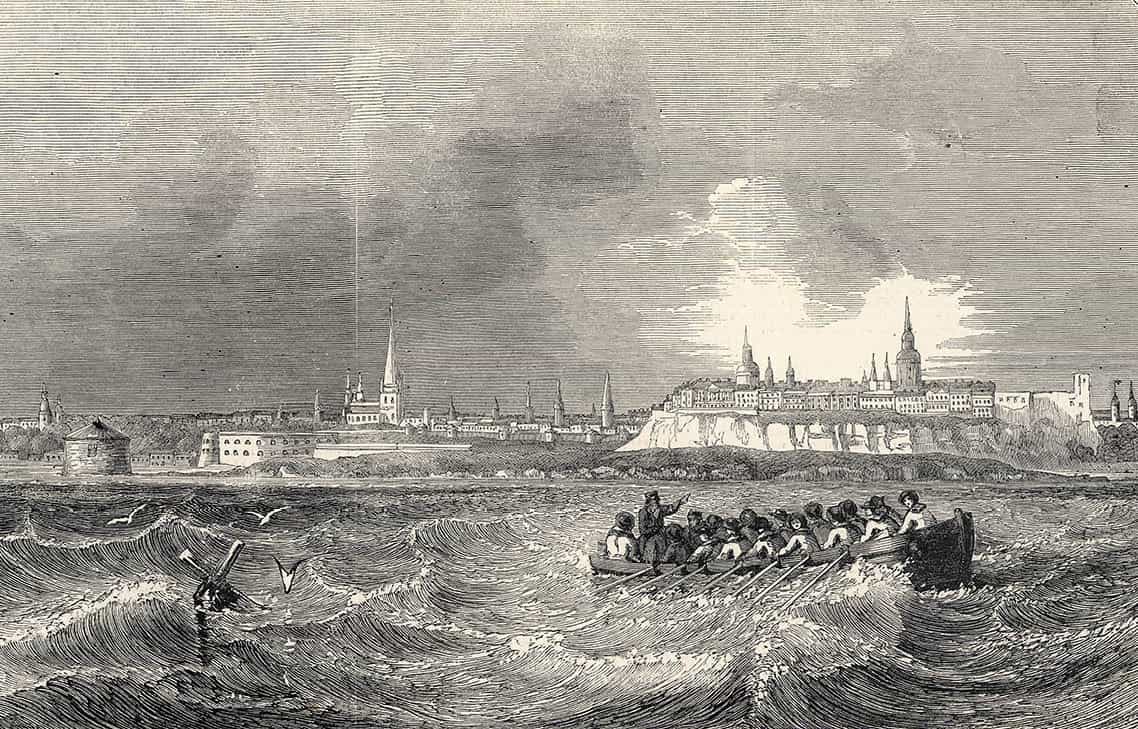
Reval [Tallinn], South Entrance to the Gulf of Finland, 1856.
Mary Evans
The battle for Narva
The outcome was the titanic struggle between Peter and the equally legendary Charles XII of Sweden. A Russian force 35,000 strong made for Narva, held by a much smaller Swedish garrison in the castle. Charles, who was not yet 20, hurried to its aid. He arrived with 8,000 men and, in the middle of a snow storm, plunged straight into battle. The Russians were cut to pieces, losing every piece of artillery Peter possessed. Charles’ advisers urged him to press on to Moscow, but the young leader had other ideas. “There is no glory in winning victories over the Muscovites,” he said breezily, “they can be beaten at any time.”
While Charles went off in pursuit of other enemies, Peter laid the foundations of Petersburg and planned a second attack on Narva. He entrusted the command to a Scot named Ogilvie, who not only succeeded in overwhelming the garrison but decided, apparently independently, to take no prisoners, military or civilian. A terrible massacre was finally stopped by the arrival of Peter the Great in the country. He is said to have ended the proceedings by cutting down some of the crazed attackers with his own sword. Moreover, he said, there was a perfectly good use for able-bodied Swedish prisoners: the conditions at the Petersburg building site were so bad that the workforce was dropping like flies.
The Estonian peasant
Early travellers were from the upper crust, and could not be expected to have much empathy with the working man. Lady Eastlake reported of the Estonian peasant, “Beyond his strict adherence to his church, we can find but little interesting in his character; excepting perhaps that of a servile obedience or cunning evasion… Provided he can have a pipe in his mouth, and lie sleeping at the bottom of his cart, while his patient wife drives the willing little rough horse… Offer him wages for his labour, and he will tell you, with the dullest bumpkin look, that if he works more he must eat more.”
Era of Russian domination
With Narva under his belt, Peter turned to Reval and its Swedish garrison. The defenders put up a great fight but ultimately they succumbed to thirst and an outbreak of plague. The Great Northern War between Peter and Charles was far from over, however, and in the course of fighting that swept across Europe the Baltic States were utterly devastated, the horror compounded by plague. With the Peace of Nystad in 1721, Sweden finally ceded its Baltic possessions, and Estonia, for one, prepared for its first taste of Russian rule.
Like the Swedes, Peter was not inclined to upset the way the German hierarchy ran Estonia, and the Estonians continued, according to one commentator, “to live and die like beasts, happy if they could subsist on dusky bread and water”.
Nothing much had changed by the middle of the 19th century. The English writer Lady Elizabeth Eastlake, who moved in privileged circles during her stay, kept her eyes open and provides a wonderful insight into conditions. The ruling Tsar Nicholas I was so paranoid about revolutionaries – the insurrections of 1848 were just around the corner – that police surveillance everywhere was oppressive. If nothing else, though, it kept crime figures low. Over a whole year, Lady Eastlake reported, there had been only 87 misdemeanours among Reval’s 300,000 population, “and five of these consist merely in travelling without a passport”.
Most illuminating of all, perhaps, are Lady Eastlake’s observations about the cloud that hung over young men in the form of military service in the Russian Army. The conscripts were chosen by ballot, No. 1 being the unlucky number. “From the moment that the peasant of the Baltic provinces draws the fatal lot No. 1, he knows that he is a Russian, and, worse than that, a Russian soldier, and not only himself, but every son from that hour born to him; for, like the executioner’s office in Germany, a soldier’s life is hereditary. . . If wars and climate and sickness and hardship spare him, he returns after four-and-twenty years of service – his language scarce remembered, his religion changed, and with not a rouble in his pocket – to seek his daily bread by his own exertions for the remainder of his life.”
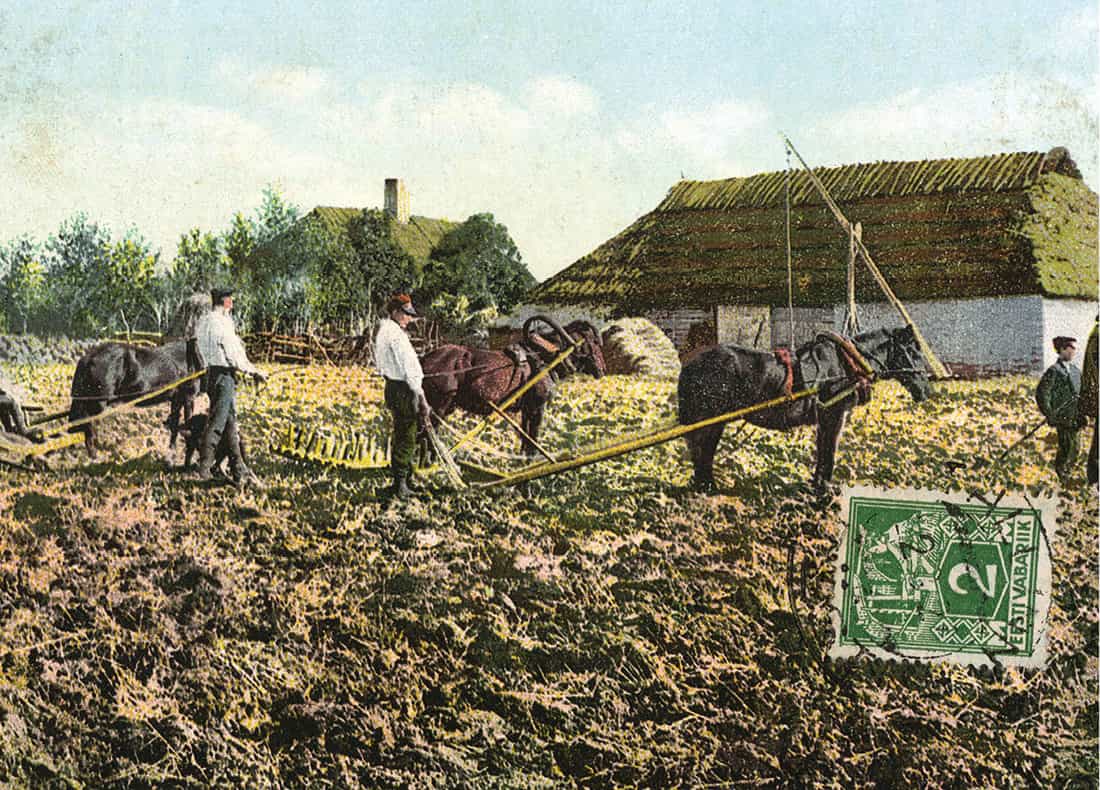
Estonian farming in the 1910s.
Mary Evans
Impossible choices
The last years of the 19th century saw the emergence of the Young Estonians, a sign of awakening nationalism. The social order as they saw it was still dominated by the German hierarchy, but being anti-German did not make them pro-Russian. They were simply against the status quo, and for people in that mood Marxism was a very reasonable answer. The savage oppression of the St Petersburg uprising in 1905 destroyed any sympathy for the tsar. For most Estonians, World War I presented an impossible choice between Germany and Russia when, in truth, they would rather have been fighting against both. Nevertheless, tens of thousands found themselves in tsarist uniform, their plea to form their own units under their own officers falling on deaf ears.
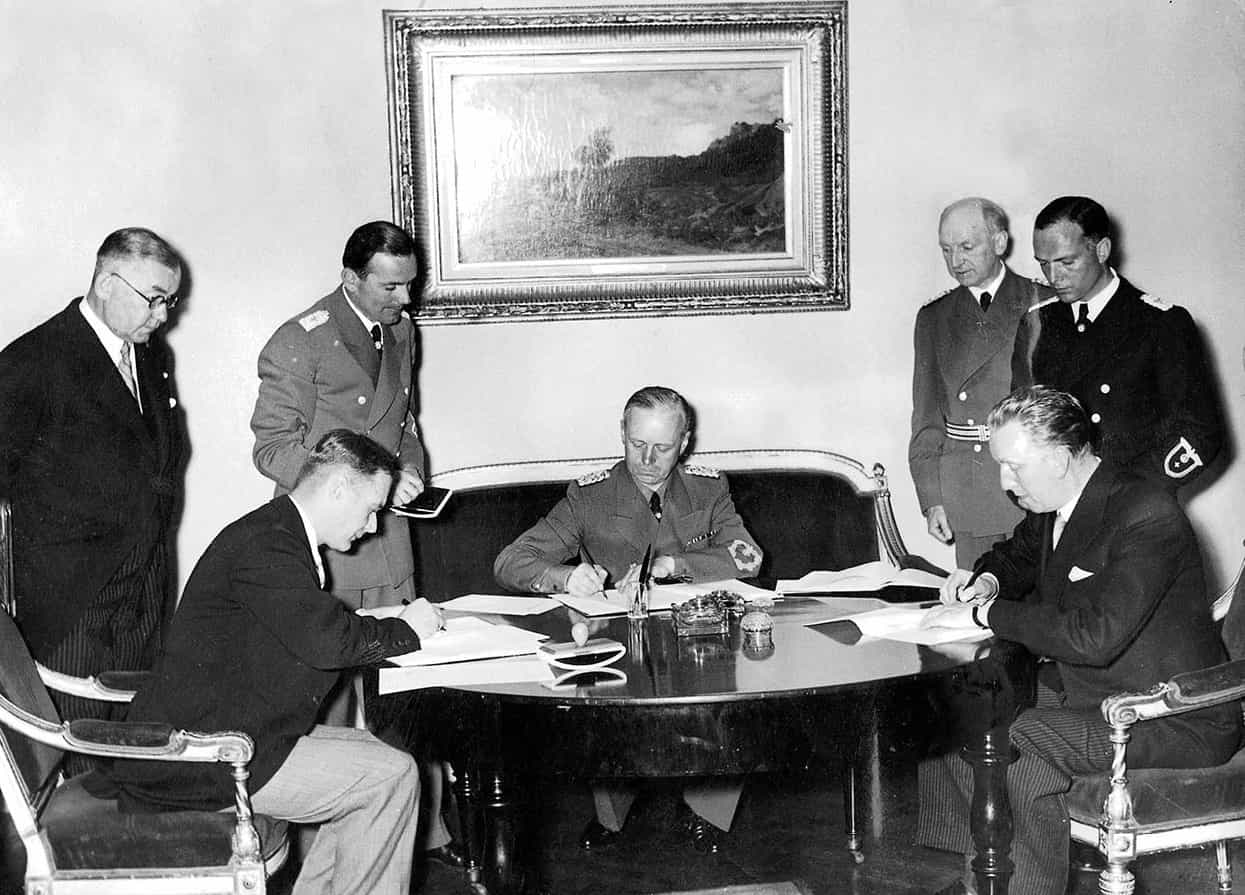
Signing the non-aggression pact with Estonia and Latvia at the Foreign Office in the Wilhelmstrasse in Berlin on 7 June 1939.
Mary Evans
The Russian Revolution in 1917 simplified the choice, the more so when it was announced that an Estonian national army was to be formed. About 170,000 volunteers immediately joined up, while many Estonians preferred to join the supposedly internationalist ranks of the Bolsheviks. From their various places of exile, members of a provisional Estonian government sent up a cry for independence.
Our Man in Tallinn: in its original outline, English novelist Graham Greene’s famous work of spy fiction, Our Man in Havana, was to have been set in Tallinn in 1938.
Numerous fierce battles were fought over Tallinn between local Bolsheviks, who were backed by Red Guards, and the nationalist irregulars, who included schoolboys and the Tallinn fire brigade. The tide at first went in favour of the Bolsheviks and by the end of 1918 they held Narva and Tartu, and Russian comrades had advanced to within 32km (20 miles) of Tallinn. The struggle amounted to civil war, and this was fought with all the savagery associated with such a terrible event.
The tide eventually turned, although not without considerable clandestine help given to the nationalists by the British Navy that involved using captured Russian destroyers and a series of raids by torpedo boats that penetrated the naval defences with which Peter the Great had ringed the Russian Baltic ports. The final battle was at Narva, and resulted in the nationalist coalition driving some 18,000 Bolsheviks across the Russian border. One year later, with the Bolsheviks still engaged in heavy fighting elsewhere, Russia renounced sovereignty over Estonia “voluntarily and for ever”.
Communists were not inclined to accept the new government. There was an attempted putsch in 1924, which resulted in street fighting in Tallinn. Numerous other disturbances were countered by increasingly authoritarian measures. In the end these amounted to dictatorship and the sad conclusion that the country was not quite ripe for parliamentary democracy.
Farms for all
Prior to the war, more than half of Estonia had belonged to 200 German-Balt families. An Agrarian Reform Law passed after independence took over all baronial and feudal estates, together with those belonging to the Church and the former Russian Crown lands. The land was redistributed and 30,000 new farms created. The lot of the previously hapless peasant was further improved by the establishment of the right to engage in trade.
Estonia was still struggling to find its feet when any gains were put in jeopardy by the secret protocol of the 1939 Nazi–Soviet Pact. Stalin and Hitler agreed that the Soviet Union would annex Estonia, Finland and Latvia, and Germany could claim Lithuania, although this was later amended to give Lithuania to Russia as well. A blatantly rigged election set the stage for an outright annexation on 6 August 1940, and almost immediately 60,000 Estonians went missing. They had been forcibly conscripted into the Soviet Army, deported to labour camps or executed.
The collapse of the Nazi–Soviet Pact naturally changed everything. German forces invaded in July 1941, meeting determined resistance in Estonia, where large numbers of Soviet troops were cut off. Estonia had only about 1,000 Jewish families, nothing like the numbers of Latvia and Lithuania, but even so 90 percent of these were murdered as Germany set about incorporating the country in the Third Reich.
By the end of the war some 70,000 Estonians had fled to the West. The population had dropped from more than 1 million pre-war to no more than 850,000. The educated classes did not wait to find out what would happen when the German forces in Tallinn surrendered to the Red Army on 22 September 1944.
Russian invasion
Tens of thousands of those who did not flee were consigned to Soviet labour camps. The vacuum was filled by the arrival of comparable numbers of Russians with the dual purpose of manning heavy industry and completing the Russification programme begun by the tsars. There was little Estonians could do except to turn their television aerials towards Finland to see how their Finno-Ugric cousins were getting along. At home, Soviet policies continued unabated, so that during the 1980s the proportion of Russians and other Soviet implants living in the country rose to 40 percent. With the whole of the country’s industry under Moscow’s remote control, no thought was given to the ecological impact of belching industrial works.
With their stars firmly hitched to Moscow’s wagon, Estonia’s loyal Communist Party members were totally opposed to any sign of a nationalist revival in Estonia. The long-term implications of Glasnost and Perestroika were, however, not lost on them, and they took no comfort at all from the 2,000 demonstrators who summoned up enough nerve to mourn the anniversary of the Nazi–Soviet Pact in Tallinn’s Hirvepark in August 1987. In this respect, the party hardliners and the large Russian minority were as one.
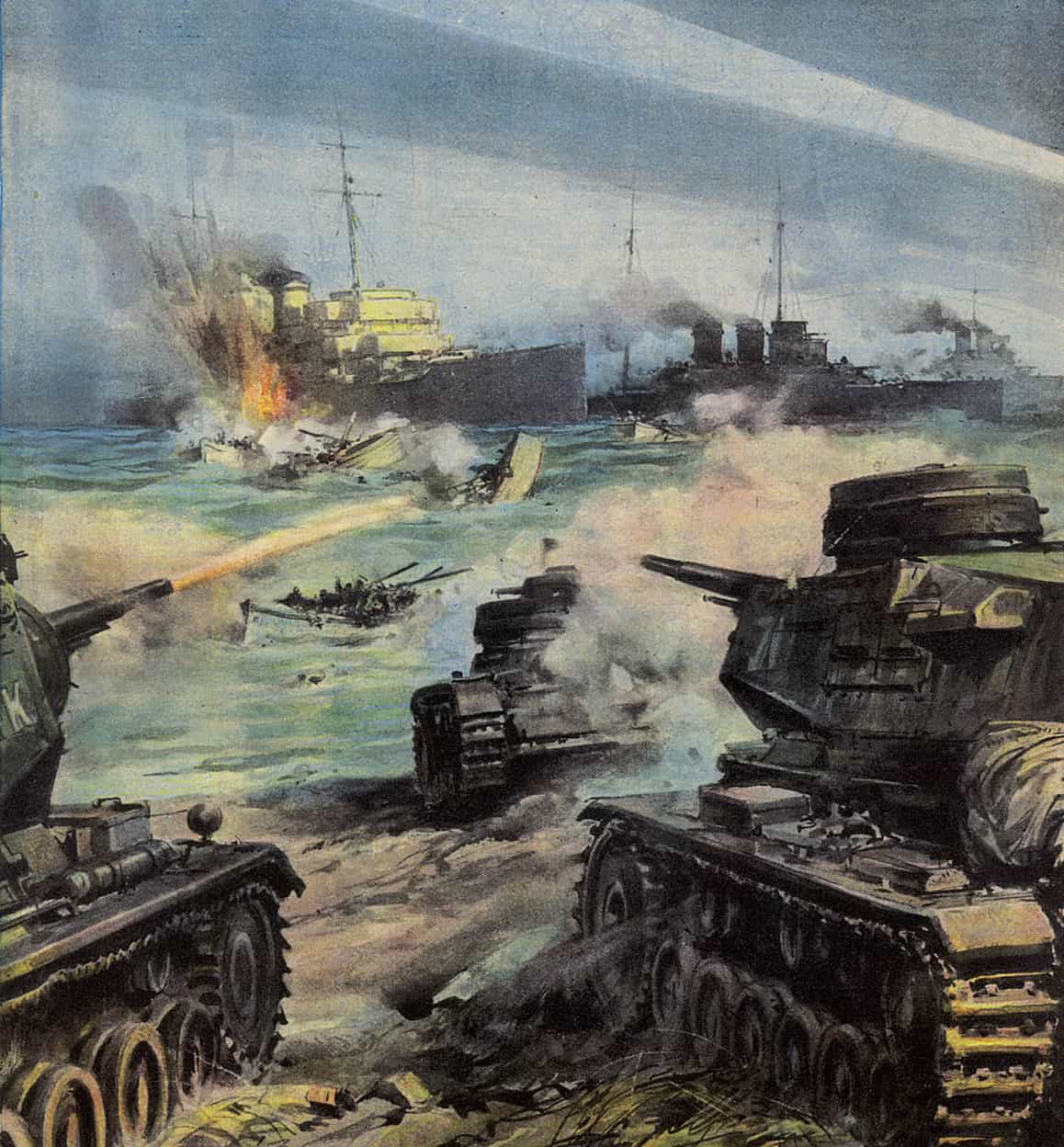
Soviet tanks thwart a German invasion of Estonia, from La Domenica del Corriere, August 1941.
Mary Evans
While members of the Estonian Heritage Society went about discreetly restoring national monuments, the radical-chic banner of environmental concern brought the independence movement to life. The first scent of this potential awakening came with the cancellation of plans for increased open-pit phosphorus mining in the northeast of the country. This was followed by demands for economic self-management and then, most extraordinarily, came the “Singing Revolution” (for more information, click here).
The extent to which the Estonian establishment fell into line with the new mood was revealed when the Estonian Supreme Soviet defied the USSR Supreme Soviet by endorsing the legitimacy of a declaration of sovereignty. In the end it took a military coup attempt in Moscow to push the independence movement to its final conclusion. On 20 August 1991, with Gorbachev under house arrest and Russian tank units rolling into Tallinn, Estonia formally declared its independence. There were tense moments as the world waited to see whether there would be a repetition of the events in Czechoslovakia in 1968. In the event, the dissolution of the Soviet Union happened so rapidly that Estonia moved gratefully to the sidelines.
The Baltic Tiger awakes
Their long-awaited dream of regaining independence now realised, Estonians were faced with the daunting realities of post-Soviet existence: decaying factories, triple-digit inflation and a colossal environmental clean-up bill.
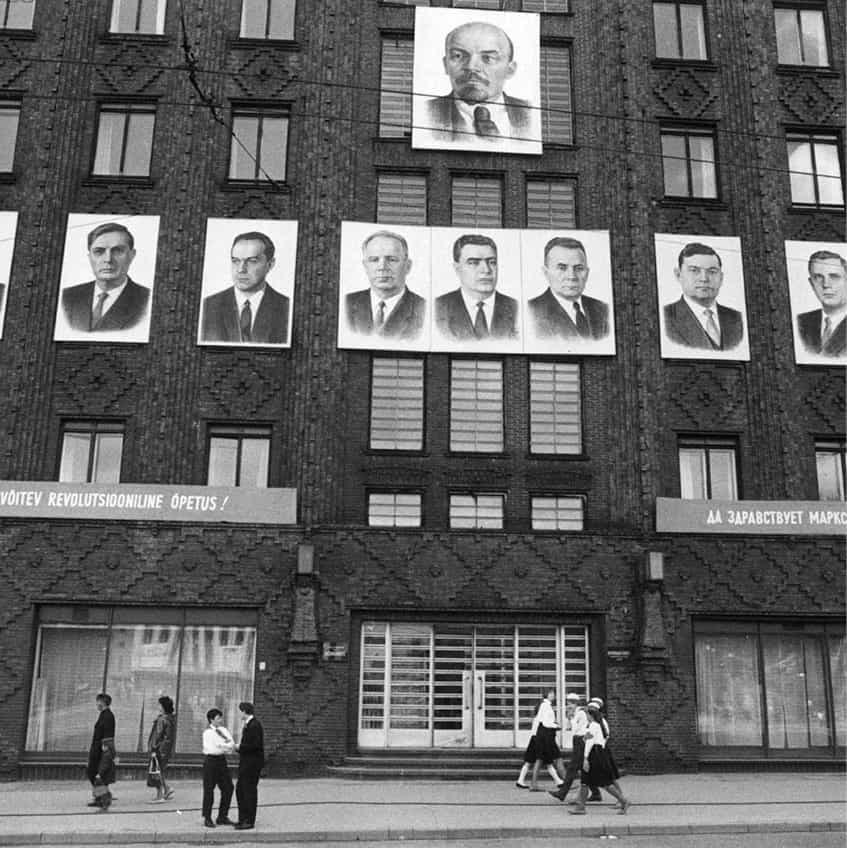
Communist Party HQ during a cultural festival, Tallinn
Mary Evans
It was the swift and daring economic reforms carried out during these crucial days that laid the foundation for the country’s “Baltic Tiger” economic growth in the mid-1990s. Aid and advice poured in from Western governments, while so-called “foreign Estonians” – those whose families had fled the 1944 invasion and settled abroad – flocked in from Sweden, North America and Australia, bringing their expertise and investment dollars. Most notably, in June 1992, the Bank of Estonia ignored IMF warnings and launched the Eesti kroon. It became the first stable currency of the former USSR, thanks in a large part to the country’s pre-World War II gold supply, which, as fortune would have it, was still kept by the Bank of England and the US Federal Reserve.
Fuelling the cautious optimism of these heady and hectic times was the prospect of ridding the Estonian territory once and for all of its many remaining Russian military forces, a job that was finally accomplished on 31 August 1994. The joy of bidding farewell to Russia’s troops was dampened three weeks later by the Estonia ferry disaster, which claimed 852 lives and left a lasting scar on the psyche of the young nation.
Finnish transmission of TV programmes from the West had a profound effect on Estonians, with Peyton Place a favourite programme of former president Lennart.
Along with fast-paced economic development, and the inevitable parliamentary scandals and corruption charges that came with it, the remainder of the decade was a time of reconnection with the West. On the international political level, an unpredictable and outspoken president, Lennart Meri, who served as head of state from 1992 to 2000, supplied world leaders with enough wry commentary on East–West relations to ensure that Estonia was never far from the minds of the major power players.
It was towards the end of the decade that the “little nation that could” hit the first serious pothole on its road to recovery. An economic slowdown in 1998, brought on by a monetary crisis in Russia, proved to any remaining doubters that, although Estonia could still fulfil its age-old role as a trade link between Russia and Europe, it was far wiser to keep its gaze firmly fixed westwards. It came as no surprise then when, in the September 2003 referendum, 67 percent of Estonians voted to join the European Union. Indeed, when the nation subsequently joined the EU – and NATO – the following year, many saw it as the final step in restoring Estonia’s proper place in the family of Western European nations.
True Europeans
Membership of the EU turned out to be a mixed blessing for the small nation. As much-needed investment and development funds poured in, talent poured out, with many young, skilled professionals moving abroad in search of better opportunities. Their absence, though, did nothing to slow the breakneck pace of development that their country was experiencing. Driven mainly by a construction and real-estate boom, the economy rocketed to levels that even the most hopeful 1990s-era reformers would never have imagined. City skylines became obscured by builders’ cranes, streets were suddenly awash with luxury cars, chic cafés opened and closed according to popular whims, and foreign tourists began visiting in droves.
The party was brought to a screeching halt by the worldwide economic crisis in 2008. Barring Latvia, no nation in Europe was harder hit by the downturn. The fragility of the nation’s new-found wealth, much of which had been fuelled by cheap loans, became all too clear. Double-digit GDP growth turned into double-digit decline while inflation soared to 20 percent. Even the nation’s famed IT sector, which had been making waves with innovations like Skype, couldn’t keep the country from slipping into recession.
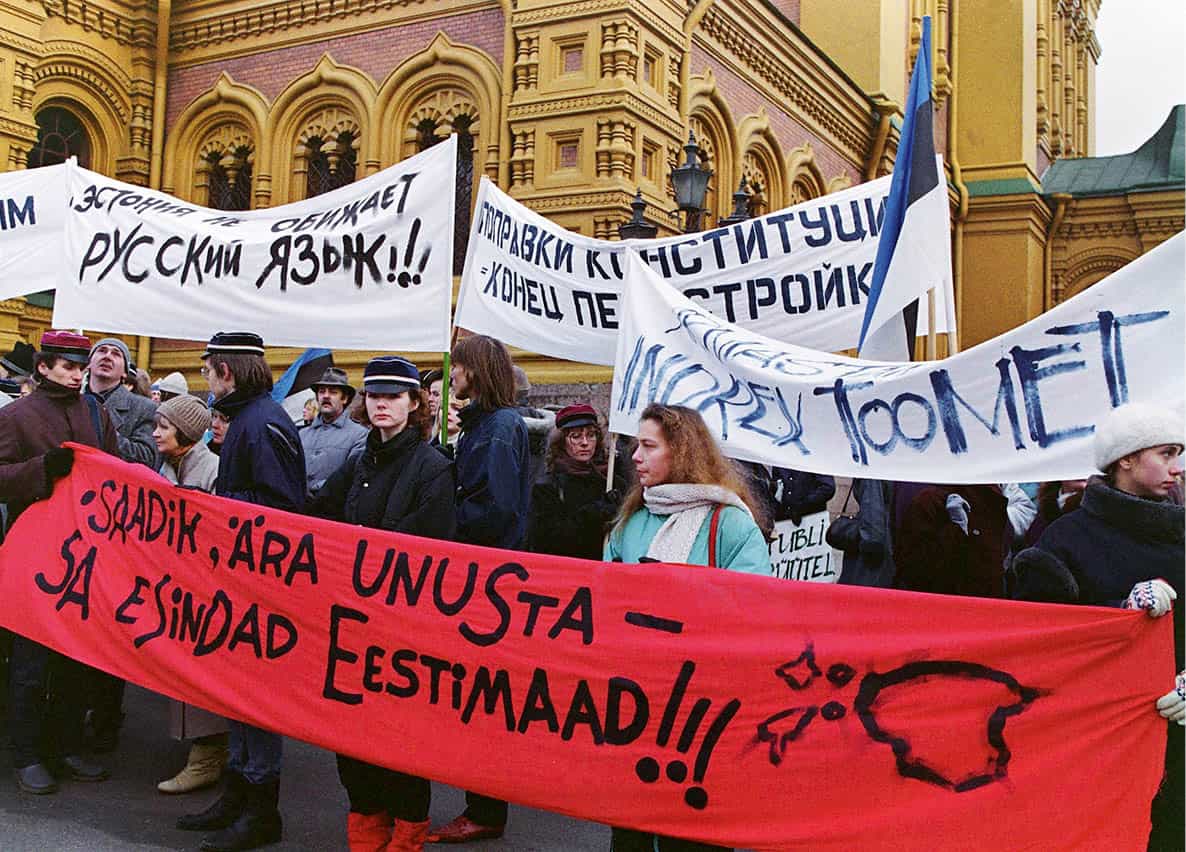
Anti-Soviet demonstration, November 1988.
Getty Images
Some respite was provided by a reserve fund that a frugal government had put away during the fat years, but the first glimmer of recovery came after Estonia, once again defying Western advisers, refused to devalue its currency. Instead it tightened its belt enough to join the Eurozone. On 1 January 2011, the nation said goodbye to its beloved kroon, which had become a symbol of its post-independence success. Estonians traded it in for a currency which they hope will bring them even deeper into the European fold and banish any notion, among investors at least, that they are “not of Europe”.
From this point, Estonia quickly sprang back to its feet with the GDP growth reaching 2.1 percent and unemployment falling to slightly over 7 percent in 2014. The e-government programme became a widely praised model solution; Estonia is probably the only country in the world where 83 percent of the households have internet capabilities, while citizens may choose from around 4,000 online services provided by the government. In 2015 an e-residence aimed at stimulating foreign investment and facilitating business activity was added.
However, economic and technological achievements have been overshadowed in recent years by a growing tension in relations with Russia following its annexation of Crimea and intervention in Eastern Ukraine. In 2015, all three Baltic states asked NATO to deploy the alliance’s permanent contingent on their soil while Estonia conducted its biggest military exercises ever. In 2017, NATO troops were finally deployed in Estonia, Latvia and Lithuania, under the Enhanced Forward Presence strategic objective.